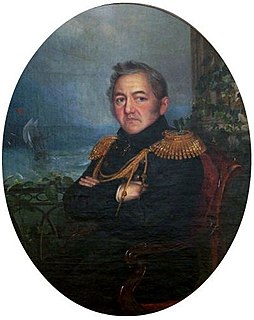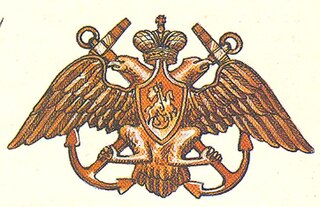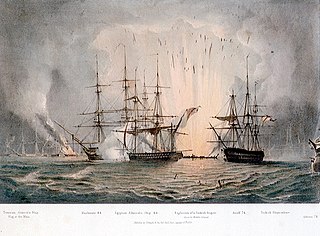
Pavel Stepanovich Nakhimov, was a Russian admiral, known as the commander of naval and land forces during the Siege of Sevastopol (1854-1855) during the Crimean War.

The Russian Navy is the naval arm of the Russian Armed Forces. It has existed in various forms since 1696; its present iteration was formed in January 1992 when it succeeded the Navy of the Commonwealth of Independent States.

Baron Ferdinand Friedrich Georg Ludwig von Wrangel was a Baltic German explorer and seaman in the Imperial Russian Navy, Honorable Member of the Saint Petersburg Academy of Sciences, a founder of the Russian Geographic Society. He is best known as chief manager of the Russian-American Company, in fact governor of the Russian settlements in present-day Alaska.

Admiral Mikhail Petrovich Lazarev was a Russian fleet commander and an explorer.

During the Napoleonic Wars, the Anglo-Russian War was the phase of hostilities between Great Britain and Russia after the latter signed the Treaty of Tilsit that ended its war with France. Anglo-Russian hostilities were limited primarily to minor naval actions in the Baltic Sea and Barents Sea.

Admiral Lord Clarence Edward Paget was a British naval officer, politician, and sculptor.

Admiral Sir James Whitley Deans Dundas GCB was a Royal Navy officer. He took part in the Napoleonic Wars, first as a junior officer when he took part in the Anglo-Russian invasion of Holland in Autumn 1799 and later as a commander when he was in action at Copenhagen Dockyard shortly after the capture of that City in August 1807. He also served as Whig Member of Parliament for Greenwich and then for Devizes and became First Naval Lord in the First Russell ministry in July 1847 and in that role his service was dominated by the needs of Whig party. He was appointed Commander-in-Chief in the Mediterranean in 1852 and led all naval operations in the Black Sea including the bombardment of Sevastopol in October 1854 during the Crimean War.

Stepan Osipovich Makarov was a Russian vice-admiral, commander in the Imperial Russian Navy, oceanographer, member of the Russian Academy of Sciences, and author of several books. He was a pioneer of insubmersibility theory, and developer of a Cyrillic-based semaphore alphabet. A proponent of icebreaker use, he supervised the first ever polar icebreaker construction. Makarov also designed several ships.

The Imperial Russian Navy operated as the navy of the Russian Tsardom and later the Russian Empire from 1696 to 1917. Formally established in 1696, it lasted until dissolved in the wake of the February Revolution of 1917. It developed from a smaller force that had existed prior to Tsar Peter the Great's founding of the modern Russian navy during the Second Azov campaign in 1696. It expanded in the second half of the 18th century and reached its peak strength by the early part of the 19th century, behind only the British and French fleets in terms of size.

Vice-Admiral Sir Richard Saunders Dundas, was a Royal Navy officer. As a captain, he took part in the capture of the Bogue forts in January 1841, during the First Opium War. He was appointed to the command of the Fleet in the Baltic Sea, in succession to Sir Charles Napier, in February 1855 and led the naval support during the latter stages of the Crimean War, enforcing a strict blockade and carrying out the bombardment of Sveaborg in August 1855. He was appointed First Naval Lord in the first Palmerston ministry in November 1857 and then, after stepping down to be Second Naval Lord during the second Derby–Disraeli ministry, he stepped up again to become First Naval Lord in the second Palmerston ministry in June 1859 remaining in office until his death. The Prime-Minister described Dundas as "a most distinguished officer".

Wilhelm Withöft, more commonly known as Wilgelm Vitgeft, was a Russia-German admiral in the Imperial Russian Navy, noted for his service in the Russo-Japanese War of 1904-1905.

Johan Hampus Furuhjelm, was a Finnish-Russian vice-admiral and explorer, commander of the Russian Baltic Fleet, Governor of the Russian Far East, Taganrog and Russian America.

Ivan Alexeyevich Shestakov was a Russian naval officer, statesman, and writer.

Mikhail Andrianovich Lavrov (1799–1882) was a Russian rear-admiral and Arctic explorer.

Admiral Sir Hastings Reginald Yelverton, was a Royal Navy officer. As a junior officer he took part in a major action against pirates off Candia in June 1826 and was involved in protecting British interests during the Portuguese Civil War during the early 1830s. He saw action in the Crimean War as Captain of one of the two ships that captured a Russian barque beneath the batteries at Ekenäs in Finland in May 1854. Then in July 1873 he took part in the suppression of the Cantonal Revolution in Cartagena. He became First Naval Lord in September 1876 and in that role implemented a series of economies demanded by the Disraeli ministry but was also involved in ordering the small, cheap and thoroughly unsuccessful ironclad Ajax-class battleships.
The Russian corvette Navarin was an Egyptian corvette captured during the Russo-Turkish War of 1828–1829 and placed into service by the Russians. She remained in the Mediterranean until 1830 when she was transferred to the Baltic Fleet. Navarin remained there until she was ordered to the Far East in late 1853. She was so badly damaged by a series of storms en route that she was deemed too expensive to repair and was sold for scrap in the Netherlands in 1854.

Gangut was an 84-gun ship of the line built for the Imperial Russian Navy in the early 1820s. She participated in the Battle of Navarino in 1827 and was credited with destroying three Ottoman ships. The ship was forced to return to the Baltic Sea for repairs and remained part of the Baltic Fleet for the rest of her career. Gangut was one of the ships deployed to Denmark during the First Schleswig War of 1848–50 to help preserve Denmark's territorial integrity against Prussia. The ship was converted to steam power in 1854–57 and she made one deployment to the Mediterranean in 1859–60 before she became a gunnery training ship in 1862. Gangut was stricken from the navy list in 1871 and sold for scrap.
Kalevala, a.k.a. "Calevala", was a propeller-operated corvette of the Finnish navy. The construction of it was completed in 1858 at Turku Old Shipyard, Finland. From 1860 to 1865, the corvette served in the Pacific Fleet of Russia. At the time, Finland was an autonomous grand duchy (1809-1917) within the Russian Empire.
















